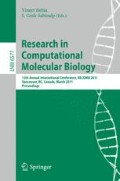Abstract
In a network orientation problem one is given a mixed graph, consisting of directed and undirected edges, and a set of source-target vertex pairs. The goal is to orient the undirected edges so that a maximum number of pairs admit a directed path from the source to the target. This problem is NP-complete and no approximation algorithms are known for it. It arises in the context of analyzing physical networks of protein-protein and protein-dna interactions. While the latter are naturally directed from a transcription factor to a gene, the direction of signal flow in protein-protein interactions is often unknown or cannot be measured en masse. One then tries to infer this information by using causality data on pairs of genes such that the perturbation of one gene changes the expression level of the other gene. Here we provide a first polynomial-size ilp formulation for this problem, which can be efficiently solved on current networks. We apply our algorithm to orient protein-protein interactions in yeast and measure our performance using edges with known orientations. We find that our algorithm achieves high accuracy and coverage in the orientation, outperforming simplified algorithmic variants that do not use information on edge directions. The obtained orientations can lead to better understanding of the structure and function of the network.
Access this chapter
Tax calculation will be finalised at checkout
Purchases are for personal use only
Preview
Unable to display preview. Download preview PDF.
References
Arkin, E.M., Hassin, R.: A note on orientations of mixed graphs. Discrete Applied Mathematics 116(3), 271–278 (2002)
Bang-Jensen, J., Gutin, G.: Digraphs: Theory, Algorithms and Applications, 2nd edn. Springer, Heidelberg (2008)
Boesch, F., Tindell, R.: Robbins’s theorem for mixed multigraphs. The American Mathematical Monthly 87(9), 716–719 (1980)
Breitkreutz, A., et al.: A global protein kinase and phosphatase interaction network in yeast. Science 328(5981), 1043–1046 (2010)
Chung, F.R.K., Garey, M.R., Tarjan, R.E.: Strongly connected orientations of mixed multigraphs. Networks 15(4), 477–484 (1985)
Fields, S., Song, O.-K.: A novel genetic system to detect protein-protein interactions. Nature 340(6230), 245–246 (1989)
Gamzu, I., Segev, D., Sharan, R.: Improved orientations of physical networks. In: Moulton, V., Singh, M. (eds.) WABI 2010. LNCS, vol. 6293, pp. 215–225. Springer, Heidelberg (2010)
Gavin, A., et al.: Functional organization of the yeast proteome by systematic analysis of protein complexes. Nature 415(6868), 141–147 (2002)
Gitter, A., Klein-Seetharaman, J., Gupta, A., Bar-Joseph, Z.: Discovering pathways by orienting edges in protein interaction networks. Nucleic Acids Research (2010), doi:10.1093/nar/gkq1207
Lee, T.I., et al.: Transcriptional regulatory networks in saccharomyces cerevisiae. Science 298(5594), 799–804 (2002)
MacIsaac, K., et al.: An improved map of conserved regulatory sites for saccharomyces cerevisiae. BMC Bioinformatics 7(1), 113 (2006)
Medvedovsky, A., Bafna, V., Zwick, U., Sharan, R.: An algorithm for orienting graphs based on cause-effect pairs and its applications to orienting protein networks. In: Crandall, K.A., Lagergren, J. (eds.) WABI 2008. LNCS (LNBI), vol. 5251, pp. 222–232. Springer, Heidelberg (2008)
Ourfali, O., Shlomi, T., Ideker, T., Ruppin, E., Sharan, R.: SPINE: a framework for signaling-regulatory pathway inference from cause-effect experiments. Bioinformatics 23(13), i359–i366 (2007)
Reimand, J., Vaquerizas, J.M., Todd, A.E., Vilo, J., Luscombe, N.M.: Comprehensive reanalysis of transcription factor knockout expression data in saccharomyces cerevisiae reveals many new targets. Nucleic Acids Research 38(14), 4768–4777 (2010)
Tarjan, R.: Depth-first search and linear graph algorithms. SIAM Journal on Computing 1(2), 146–160 (1972)
Yeang, C., Ideker, T., Jaakkola, T.: Physical network models. Journal of Computational Biology 11(2-3), 243–262 (2004)
Yu, H., et al.: High-Quality binary protein interaction map of the yeast interactome network. Science 322(5898), 104–110 (2008)
Author information
Authors and Affiliations
Editor information
Editors and Affiliations
Rights and permissions
Copyright information
© 2011 Springer-Verlag Berlin Heidelberg
About this paper
Cite this paper
Silverbush, D., Elberfeld, M., Sharan, R. (2011). Optimally Orienting Physical Networks. In: Bafna, V., Sahinalp, S.C. (eds) Research in Computational Molecular Biology. RECOMB 2011. Lecture Notes in Computer Science(), vol 6577. Springer, Berlin, Heidelberg. https://doi.org/10.1007/978-3-642-20036-6_39
Download citation
DOI: https://doi.org/10.1007/978-3-642-20036-6_39
Publisher Name: Springer, Berlin, Heidelberg
Print ISBN: 978-3-642-20035-9
Online ISBN: 978-3-642-20036-6
eBook Packages: Computer ScienceComputer Science (R0)

